
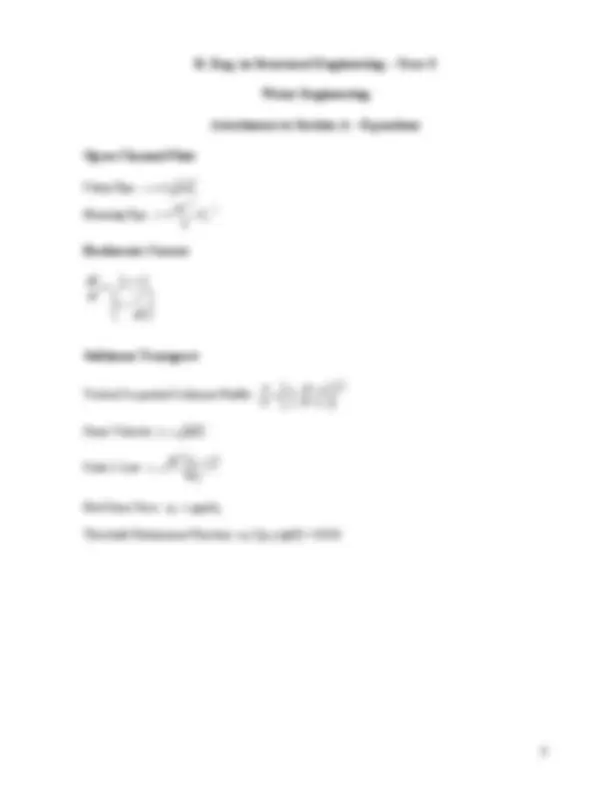
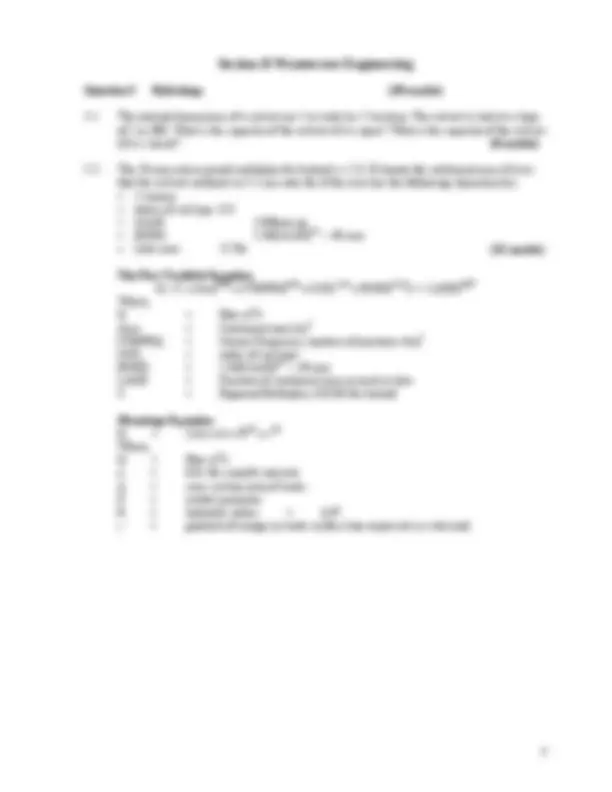
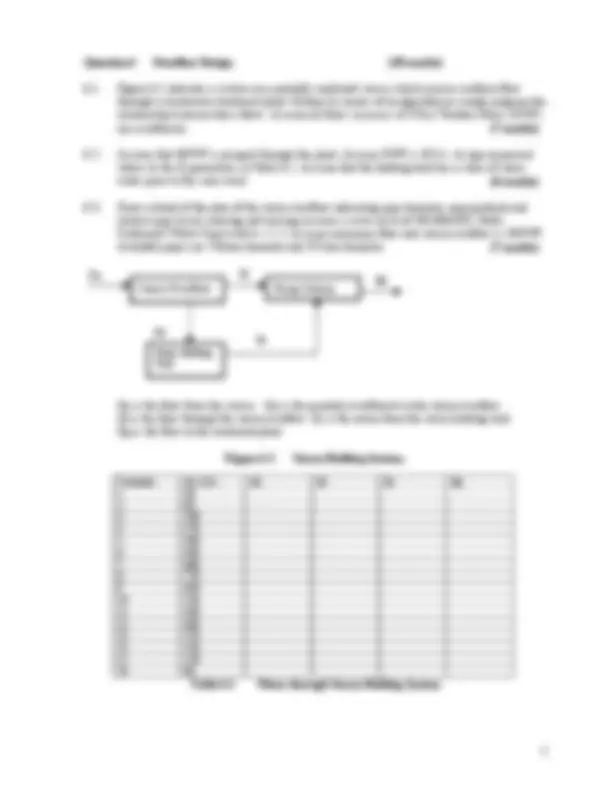
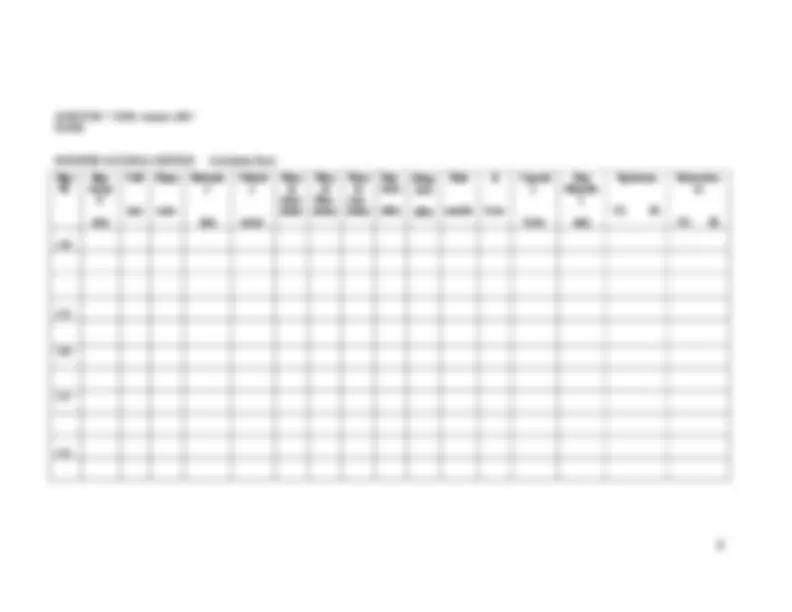

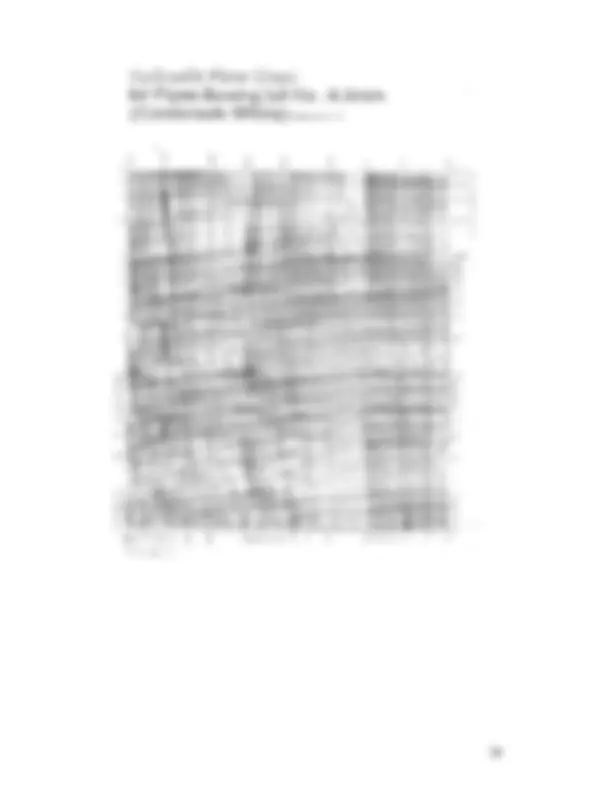


Study with the several resources on Docsity

Earn points by helping other students or get them with a premium plan


Prepare for your exams
Study with the several resources on Docsity

Earn points to download
Earn points by helping other students or get them with a premium plan
Community
Ask the community for help and clear up your study doubts
Discover the best universities in your country according to Docsity users
Free resources
Download our free guides on studying techniques, anxiety management strategies, and thesis advice from Docsity tutors
The instructions and questions for a 3-hour water engineering exam for students in the bachelor of engineering in structural engineering – stage 3 program at cork institute of technology. The exam covers topics such as open channel flow, river water level measurement, sedimentation, and wastewater engineering. Students are required to answer five questions in total, with a minimum of two questions from each section. The exam is overseen by several examiners, and calculators are not permitted. Attachments with equations and diagrams.
Typology: Exams
1 / 11

This page cannot be seen from the preview
Don't miss anything!







Answer five questions in total, a minimum of Examiners: Dr. J. Harrington two questions from each Section Dr. J.D. Murphy Use separate answer books for each section Prof. P. O’ Donoghue Programmable calculators are not permitted Mr. T. Corcoran All questions carry equal marks Attachments including figures and equations
Note: Attachment with equations
(b) A channel of rectangular cross-section 12m wide with a slope of 1 in 2000 has a water depth of 3.5m. The Manning roughness coefficient is 0.025. A dam is built downstream. If the depth of water at the dam is 6m, find how far upstream it will be 4.5m. (10 marks)
(b) A wide river with a flow depth of 3m, a mean velocity of 1 m/sec and a Chezy coefficient of 50 m1/2^ /sec contains sediments of density 2650kg/m^3. A sample of the suspended sediment load taken at mid depth shows a concentration of 200 mg/l. The sediment has a settling velocity of 3.18 x 10 -4^ m/sec. Establish the suspended sediment profile as a function of depth given a k value of 0.4. Also calculate the suspended load assuming a homogenous concentration distribution. (10 marks)
(b) A river with a low flow of 7.5 m3/sec with a corresponding 1 mg/l BOD5 level receives a discharge from a wastewater treatment plant serving an urban area with a population equivalent of 70,000, which complies with the Urban Wastewater Directive 25/35 standard. Determine the maximum downstream BOD5 level. Comment on the assumptions made in your analysis. Do you consider the downstream water quality to be adequate? Please support your answer. (10 marks)
(c) Discuss water quality in the context of chemical related illness. (5 marks)
( b) A water treatment plant built in Ireland in the 1970’s supplies a community with a population equivalent of 25,000 with water. It receives its supply from a nearby lake, which now suffers eutrophication problems.
Estimate the demand from the community. Outline the likely treatment process within the plant, size the main elements for the treatment process and quantify the daily amount of any chemicals used.
The local authority is now investigating measures to improve the water quality of the supply. Suggest at least 2 possible changes to the treatment process.
Element Design Parameter Design Parameter Value Radial Flow Tank Retention Time Loading Rate
2 - 4 hours 1 – 1.5 m/hour Upward Flow Sludge Blanket Tank
Retention Time Loading Rate
1 – 2.5 hours 2 – 2.5 m/hour DAF Unit Retention Time 30 mins. (Floc. Tank) 20 mins. (Flotation Tank) Slow Sand Filter Filtration Rate 0.1 – 0.2 m/hour Rapid Gravity Filter Filtration Rate 5 – 20 m/hour
Chemical Dosage Conc. (mg/l) Chemical Dosage Conc. (mg/l) Activated Carbon 5 Chlorine 0. Soda Ash 1 Fluoride 0. Alum 15 Lime 5 Polyelectrolyte 0.
(10 marks)
Question 5 Hydrology (20 marks)
5.1 The internal dimensions of a culvert are 5 m wide by 2.5m deep. The culvert is laid at a slope of 1 in 300. What is the capacity of the culvert if it is open? What is the capacity of the culvert if it is closed? (8 marks)
5.2. The 20 year return period multiplier for Ireland is 1.54. Estimate the catchment area of river that the culverts outlined in 5.1 can cater for if the river has the following characteristics: 7 streams Index of soil type 0. SAAR 1200mm pa RSMD 2.48(SAAR)0.5^ – 40 mm Lake area^ 15 Ha^ (12 marks)
The Five Variable Equation Q = C x Area 0.87^ x STMFRQ 0.31^ x SOIL 1.23^ x RSMD1.17^ (1 + LAKE) 0. Where, Q = flow m^3 /s Area = Catchment area km^2 STMFRQ = Stream Frequency, number of junctions /km^2 SOIL = index of soil type RSMD = 2.48(SAAR)0.5^ – 40 mm LAKE = Fraction of catchment area covered in lake C = Regional Multiplier, 0.0183 for Ireland
Mannings Equation Q = (1/n) x A x R2/3^ x s 1/ Where, Q = flow m^3 /s n = 0.01 for smooth concrete A = cross section area of water P = wetted perimeter R = hydraulic radius = A/P s = gradient of energy or water surface line expressed as a decimal
Question 6 Overflow Design (20 marks)
6.1. Figure 6.1 indicates a system on a partially combined sewer, which ensures uniform flow through a wastewater treatment plant. Outline by means of an algorithm or simple program the relationship between these flows. Assume all flows in excess of 3 Dry Weather Flows (DWF) are overflowed. (7 marks)
6.2. Assume that 3DWF is pumped through the plant. Assume DWF is 40 L/s. Assign numerical values to the Q parameters in Table 6.1. Assume that the holding tank has a store of storm water prior to this rain event. (6 marks)
6.3. Draw a detail of the plan of the storm overflow indicating pipe diameter, pipe gradient and relative pipe levels entering and leaving (assume a cover level of 100.00AOD). Refer Colebrook White Chart with ks = 1.5. Assume maximum flow into storm overflow is 20DWF. Available pipes are 750mm diameter and 375mm diameter. (7 marks)
Qe is the flow from the sewers. Qo is the quantity overflowed in the storm overflow. Qt is the flow through the storm overflow. Qr is the return from the storm holding tank Qp is the flow to the treatment plant.
Figure 6.1 Storm Holding System.
T minutes Qe (L/s) Qo Qt Qr Qp 1 30 2 90 3 180 4 270 5 360 6 480 7 600 8 750 9 630 10 540 11 480 12 369 13 270 14 210 15 150 16 60 Table 6.1 Flows through Storm Holding System
Storm Overflow
Storm Holding Tank
Pump Station
Qe
Qo Qr
Qt (^) Qp
Question 7 Sewer Design
A short storm-water sewer is shown in Figure 7.1. The sewer consists of five individual pipes. The lengths of the pipes and the catchments are shown.
Use the (^) Dillon equation to establish rain intensity , i = 152.4 Tp 0.2^ / t 0. i is rain intensity in mm/hr, Tp is the return period and t is the storm duration in minutes.
Use the Modified Rational method to establish flow, Q = 2.71 i A Q is the flow in L/s, i is rain intensity in mm/hr and A is the impermeable area in Ha.
Design the sewer in Figure 7.1, for a return period of 5 years using the Wallingford Procedure. Indicate the pipe diameters & pipe slopes.
Indicate the cover levels and invert levels at each manhole and the invert levels of incoming pipes of different diameter. Attachments: Colebrook White Chart with Ks = 0.6 and Wallingford design sheet
CL 101.02 CL 101. IL S1 S3 IL
1.00 2. S2 S4 CL 100. CL 100.63 IL IL 1.01 2.
S5 CL 100. IL
1.
S6 CL 99. IL
Sewer Length(m) Catchment Ha 1.00 40 0. 1.01 20 0. 2.00 30 0. 2.01 50 0. 1.02 30 0.
Figure 7.1 Stormwater Sewer.
QUESTION 7. DSE3. Autumn 2005.NAME:MODIFIED RATIONAL METHOD
Calculation Sheet.
PipeNo.
PipeLength (m)
Fall (m)
Slope m/m
Diamete
r (m)
Velocit
y m/sec
Time
of entry(min)
Timeofflow(min)
Timeofconc.(min)
Imp.Area(Ha)
Σ Imparea(Ha)
Rain mm/hr
Q L/sec
Capacit
y L/sec
Req Diamete
r (m)
UpstreamCL
IL
Downstrea
m CL
IL
1.00 1.01 2.00 2.01 1.
Question 8 Wastewater Treatment (20 marks)
A treatment plant is proposed for a town with a population equivalent (PE) of 500000. The plant will be designed to cater for a hydraulic flow of 3DWF. Assume for this plant that 1PE equates to 60g BOD/day and 210L/PE/day.
The treatment process incorporates primary sedimentation followed by conventional aeration.
8.1. Establish the size of the primary sedimentation tanks. (3 marks)
8.2 Establish the volume of the conventional aeration basin. (3 marks)
8.3 Produce a graph of cost of electricity (to supply oxygen) in €pa against MLSS concentration. Assume 1kWh provides 1 kg of oxygen, 1kWh costs €0.09. (8 marks) 8.4 Outline in simple terms your understanding of nitrification and denitrification. (4 marks) 8.5 Produce a graph of the relationship between temperature and solid retention time for production of nitrifying bacteria. Comment on the ability of conventional aeration plants to achieve nitrification and denitrification. (2 marks)
Sedimentation Parameters
OD = 0.75 Q (BODi – BODe) + 2Va.MLSS Formula 8. Where OD is oxygen demand g/h 0.75 applies only for settled wastewater Q is flow through plant m^3 /h BODi and BODe are the influent and effluent BOD levels in mg/L Va is the volume of the basin in m^3 MLSS is the concentration of mixed liquor suspended solids in g/L
Process F/M
kgBOD/d kg MLSS
BOD loading KgBOD/m 3 /d
Hydrauli c retention time hours
Sludge Age days
MLSS
mg/L
BOD removal efficiency %
Sludge production KgDS/kgBOD removed
Conventional Aeration
0.2 – 0.5 0.5 – 1.5 5 – 14 3-10 2000 – 3000
90 1.
Table 8.1. Loading and Operating Parameters for Conventional Aeration Treatment Processes.